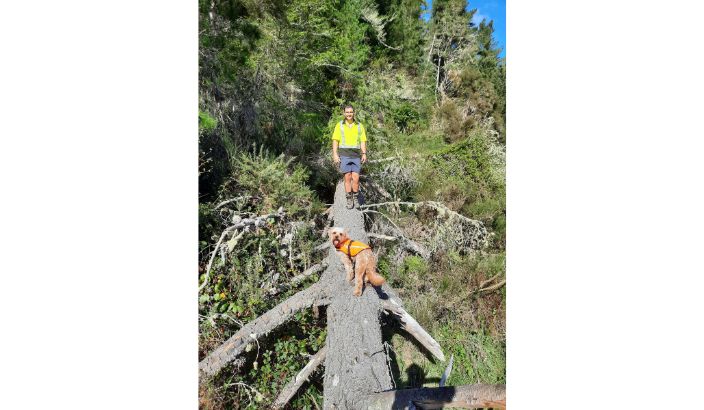Farmers need to see the trees for the wood

Richmond-based Sam Nuske, with his dog Alfie, is encouraging farmers and landowners to explore the valuable opportunities mixed land use can offer. Photo: Supplied.
A Richmond-based forestry manager is encouraging farmers and landowners to see the opportunities that forestry can provide as part of mixed land use.
“Forestry and farming are often viewed as rivals in New Zealand, meaning some landowners stubbornly persist with one or the other,” says Sam Nuske from PF Olsen.
“Farmers, landowners, and rural advisors need to see the opportunities that forestry can provide as part of mixed land use.”
Sam says that The NZ Emission Trading Scheme (ETS), the Government’s main tool for reducing greenhouse gas emissions, has changed the game for how valuable forestry can be for farmers.
“Farmers can now achieve annual returns significantly higher from forestry than sheep and beef on less productive parts of their farm, as well as the harvest revenue.”
However, he does recommend that farmers exploring forestry as part of mixed land use should seek forestry advice and says that forestry assets can also help with family succession planning, providing valuable income and assets that can be easily separated from the land value.
“I’m encouraging landowners to be bold in their thinking when considering forestry.
“Don’t muck around with a few hectares here and there. Identify the least productive 20-30 percent of your farm so you can spread costs such as machinery transportation and infrastructure construction.”
Tasman-based sheep and beef farmer, and Beef and Lamb Farmer councillor, Tarsh Newport, was one of the many farmers who supported a large campaign held earlier in the year that focused on getting the Government to curb the out-of-control conversions of productive land into carbon.
“Farmers are not anti-forestry, many of us already have trees and are planning on planting more, but we believe in the right tree, right place, and right purpose,” she says.
“Mixed land use is certainly not a push for blanket farming of pines but a view to planting the right trees in the right place to benefit your business.
“There is certainly a lot to consider, food for thought, and if considering forestry options chat with a farmer who has gone down this path already.”
Sam says that it’s important to get advice and then make informed decisions about what is best for the future of your property and business.
“There may be parts of your farm that are less accessible for harvesting, and these areas are probably more suited to a longer rotation species for carbon revenue.
“There will also be areas that are more suited to native tree species.”
Native trees are a great option for permanent riparian and aesthetic planting.
Planning these areas to meet the ETS requirements means you can at least get some carbon or economic return on top of the environmental benefits like property aesthetics, stock shelter, improved water quality, biodiversity, and soil and erosion protection.
Sam says that he doesn’t support large-scale permanent pine forestry converting to natives purely for financial investment.
“Converting to natives just for financial investment will leave you very exposed to policy changes and carbon price movement.”
While the ETS is not a silver bullet, Sam says that every little bit helps mitigate climate change.
“Mixed land use can increase the resilience of your property, as well as improve the aesthetics, water quality, and biodiversity in your environment. It’s really worth exploring.”
